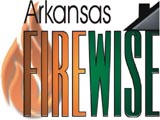

Your first defense against wildfire is to create a FireWise landscape around your home. This can be achieved by removing flammable vegetation and replacing it with fire-resistant plants; spacing the plants in your yard; and clearing away dead leaves on your roof and dry brush around your home.
Clearing all flammable vegetation a minimum of 30 feet around your home and other structures will not only provide you with the greatest chance for survival, it is also required by California law.
But this does not mean you have to live with a ring a bare dirt around your
home. You can create a defensible space and also beautify your property.
Fire Safe Landscaping
You can start with the native vegetation around your home. Many of the plants
that grow naturally in your area are highly flammable during the summer and
can actually "fuel" a wildfire, causing it to spread rapidly through
your neighborhood. Removing flammable native vegetation and replacing it with
low-growing, fire resistive plants is one of the easiest and most effective
ways to create a defensible space.
You should select landscape vegetation based on fire resistance and ease of maintenance, as well as visual enhancement of your property. In general, fire resistive plants:
- grow close to the ground;
- have a low sap or resin content;
- grow without accumulating dead branches, needles or leaves;
- are easily maintained and pruned;
- and are drought-tolerant in some cases.
If you have heavily wooded areas on your property, remove some of the trees to decrease the fire hazard and improve growing conditions.
Stack firewood and scrap wood piles at least 30 feet from any structure.
Clear flammable vegetation for at least 10 feet around LPG tanks.
Some of the more common species of fire resistive plants are rosemary, African daisy, ice plant and periwinkle.
Contact your fire department or local nursery to find out which fire resistive
plants are adapted to the climate in your area. Stay away from unsafe ornamental
landscaping plants, such as junipers, which may actually increase the fire
risk your home faces.
- Vary the height of your landscape plants and give them adequate spacing.
The taller your plants are, the wider apart they should be spaced.
- Remove dead limbs overhanging your roof and any limb within 10 feet of your
chimney.
- Work with your neighbors to clear common areas between houses, and prune
areas of heavy vegetation that are a threat to both.
- Avoid planting trees under or near electrical lines, where they may grow
into or contact the lines under windy conditions, causing a fire.
- If you have a heavily wooded are on your property, remove some of the trees
to decrease the fire hazard and improve growing conditions. Also, remove dead,
weak or diseased trees and trees with an obvious lean, leaving a healthy mixture
of older and younger trees.
- Properly dispose of all cut vegetation by an approved method. Open burning
may require a burning permit. Contact your fire department for local requirements.
- Stack firewood and scrap wood piles at least 30 feet from any structure.
And clear away any flammable vegetation within 10 feet of these wood piles.
Many homes have survived as a fire moved past, only to burn later from a wood
pile that ignited after the firefighters moved on to protect other homes.
- It is recommended that you locate liquefied petroleum gas (LPG) tanks and
any fuel storage containers at least 30 feet from any structure. Clear flammable
vegetation at least 10 feet around all such tanks.
- Clear pine needles, leaves or other debris from the roof of your house and
any other buildings on your property.
- Check and clean your roof and gutters several times during the spring, summer
and fall to remove this debris that can easily ignite from a spark.
- Remember that after you have established your Fire Safe landscape, you must
maintain it regularly. If you have any questions about creating or maintaining
a defensible space around your home, contact your local fire department.